 Facebook
Facebook
 X
X
 Instagram
Instagram
 TikTok
TikTok
 Youtube
Youtube
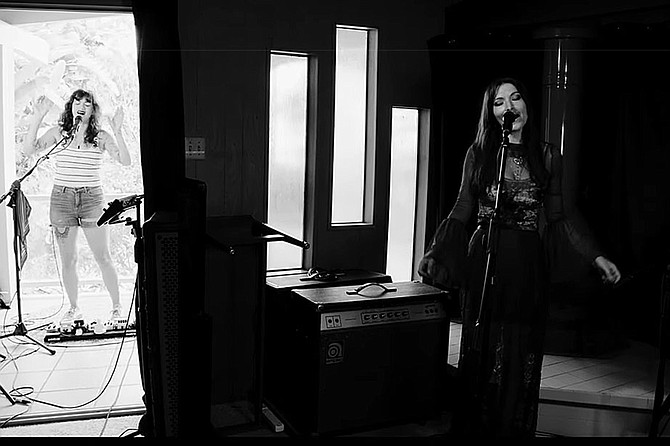
Despite the pandemic lockdown, locals have managed to shoot and release some terrific music videos this year, and Belladon is responsible for one of them. Their performance video for “Haisa” was taped August 2 as part of a two-song Halfway Home session that can be viewed online. The slowed down version of their EP track features the members seen individually in black-and-white clips, the keyboardist masked, and the dual female vocalists singing in opposing locales: one indoors, rain fogging up the windows behind her, while the other stands in an open doorway, a forest visible just outside her doorstep. Both harmonize beautifully as they plaintively sing “How am I staying alive, trapped in my soul, not my body?” Even the band seems momentarily taken aback at the end, as you can hear someone say at the close “That felt nice, I’m happy with that.” The second song of their Halfway Home performance “Shoot,” from their Dreading EP, takes what was already a rocking anthem and blows it up into full-on jam band mode.
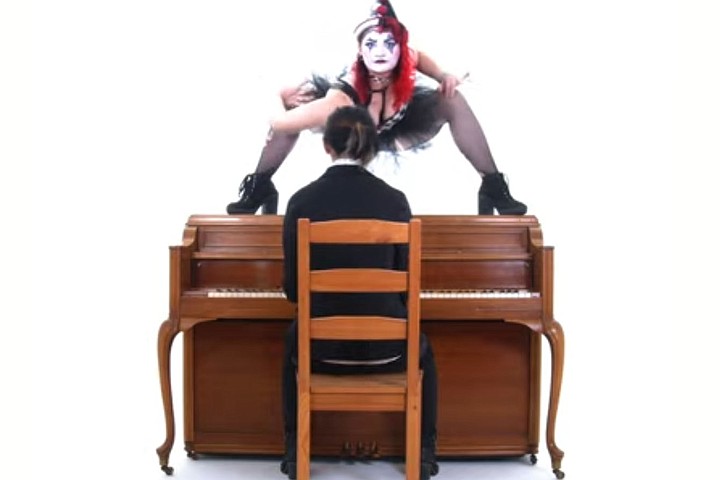
Linda Vista-based Saki integrates poetry, music, choreography, videography, and mixed media arts to create a contemporary classical-new music endeavor called A Stray Catalyst. “I really like showing up to open mics with an autoharp or an accordion instead of a guitar, because it exposes people to sounds they may not have considered functional outside of, say, polka music,” says Saki. “I can incidentally do the splits while playing accordion, but this party trick hasn’t found its way into my act yet.” The video for the title track of this year’s Solitaire For Two album features Saki at the piano while a Harley Quinn-esque mime performs. Saki describes it as “Kind of a queer romance between two characters who presumably represent the heart and the mind. The lyrics go ‘The head beats the heart every time they play a game of checkers,’ and one of my friends, Scarlet Checkers, is a clowntortionist, and I thought she’d be perfect for this video… the hardest part was finding a venue to record at during lockdown, and what ended up happening was I built the set in my living room from stuff I bought at Home Depot. It’s crazy what can be done with a small budget.”
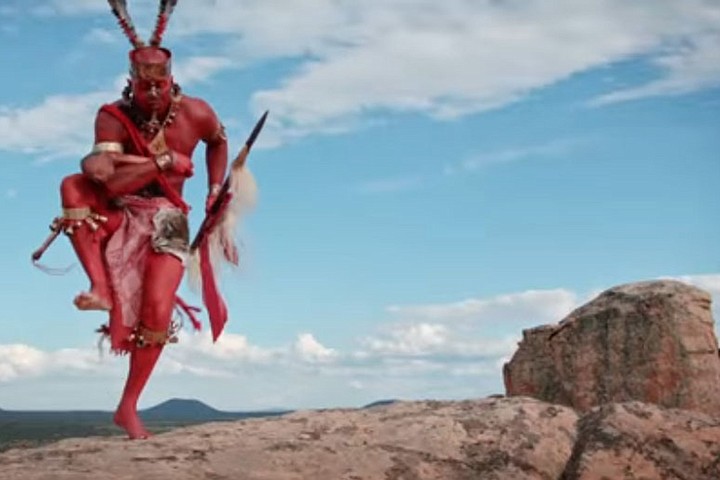
Leafar Seyer and Dave Parley, aka dusty monochrome rockers Prayers, released a video for their track “Choloani” that qualifies as an historical film. Shot in high desert of central Tseewahktehtlahn, spoken word segments feature Teypohs’weepeehl (Iron Jacket), a member of the Chichimeca tribe who shares the history of modern day cholo subculture. Says Seyer, “The yauh’kweehkahtseehntleeh or sacred opposition song that Teypohs’weepeeh sings is over 30,000 years old and has not been heard for 300 years by anyone outside of the few remaining, language speaking, traditional Cheecheemehkah who have still kept this tradition and custom.” The warrior society went underground after the scalplock bans of the 16th century and then became the choloani of the 17th, 18th and 19th centuries. “This diaspora’s descendants of hostiles and renegades, of cholohahneeh or choloh, raised and tempered in the colonial penal systems of New Spain, which would later become the penal systems of Mexico, and which would become the prison and jail systems of the united states in 1848, is what created and cultivated the cholohahneeh or chohloh culture still present in prisons systems of Califas and the southwest. [It’s] still present in the oldest remaining still hostile varrios and neighborhoods throughout Califas and the Southwest where still lives on the very last remnants, lineages, traditions, and customs of our people’s ancient warrior societies and warrior culture. This is what it means to be a cholo.”
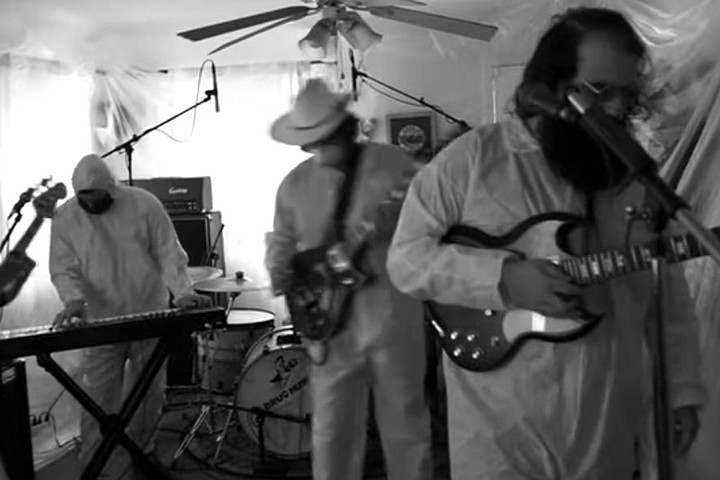
Alt-country blues rockers Drug Hunt used the pandemic lockdown as both subject and setting for their “Live from the Quarantine” video, which opens with audio recordings of early TV news announcements about the growing virus threat. Clocking in at nearly 15 minutes, the clip features the band wearing quarantine scrubs for a raucous indoor performance staged within a tiny plastic-lined safe room. “As artists, it is our duty to synthesize the current state of humanity and present our interpretations in the form of an expression worthy of inspiration,” says guitarist Rory Morison. “This live performance is our artistic response to the grief, anger, fear, and confusion caused by the global pandemic, the senseless assassination of George Floyd, and the activism necessary to bring equality and justice to people of color. For too long, rampant corruption and unchecked police brutality has taken the lives of countless innocent people. We stand proudly alongside our brothers and sisters, speaking out against the deeply entrenched overt and systemic racism that so blatantly infests our everyday lives.”
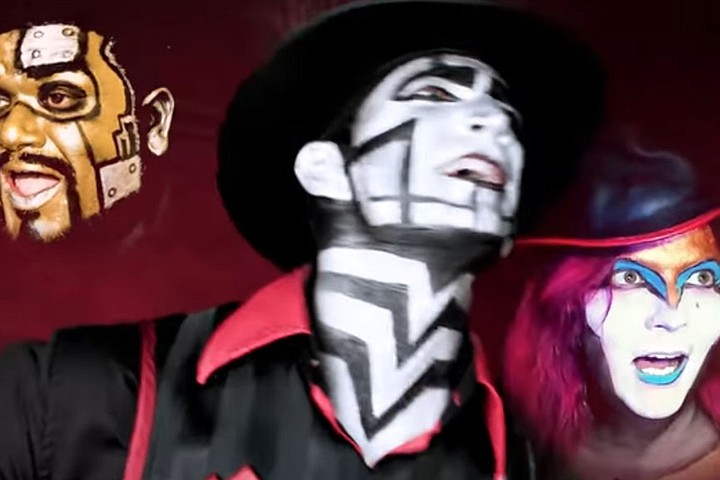
Local costumed bands (Tragic Tantrum, the Locust, Holy Molar, Geezer, etc) tend to make engaging music videos. The trio composing Steam Powered Giraffe dress up as musical steampunk robots whose elaborate fictional backstory unfolds over the course of their videos, including a jaw-dropping clip for their acoustic rendition of “Hot on the Trail,” from their current album 1896. Already one of the strongest gospel-tinged tunes they’ve recorded, the acoustic arrangement showcases David Michael Bennett’s vocal chops right from the plaintive opening line, commanding attention and demanding an instant replay as soon as the final note fades. The video is the sort of evergreen that could both make and define this band, possibly introducing and endearing them to the same supportive audience that favors likeminded theatrical rockers such as Gogol Bordello, Lana Del Rey, Queen, and Evanescence. There’s essentially a whole separate album of acoustic 1896 arrangements, all of them individualized so the strength of the songwriting paired with the shimmering vocal harmonies isn’t so much unplugging as it is upgrading. Crosby, Stills, and Nash would change the oil in Neil Young’s pickup truck for a year to sparkle this brightly at the mic again.


Despite the pandemic lockdown, locals have managed to shoot and release some terrific music videos this year, and Belladon is responsible for one of them. Their performance video for “Haisa” was taped August 2 as part of a two-song Halfway Home session that can be viewed online. The slowed down version of their EP track features the members seen individually in black-and-white clips, the keyboardist masked, and the dual female vocalists singing in opposing locales: one indoors, rain fogging up the windows behind her, while the other stands in an open doorway, a forest visible just outside her doorstep. Both harmonize beautifully as they plaintively sing “How am I staying alive, trapped in my soul, not my body?” Even the band seems momentarily taken aback at the end, as you can hear someone say at the close “That felt nice, I’m happy with that.” The second song of their Halfway Home performance “Shoot,” from their Dreading EP, takes what was already a rocking anthem and blows it up into full-on jam band mode.

Linda Vista-based Saki integrates poetry, music, choreography, videography, and mixed media arts to create a contemporary classical-new music endeavor called A Stray Catalyst. “I really like showing up to open mics with an autoharp or an accordion instead of a guitar, because it exposes people to sounds they may not have considered functional outside of, say, polka music,” says Saki. “I can incidentally do the splits while playing accordion, but this party trick hasn’t found its way into my act yet.” The video for the title track of this year’s Solitaire For Two album features Saki at the piano while a Harley Quinn-esque mime performs. Saki describes it as “Kind of a queer romance between two characters who presumably represent the heart and the mind. The lyrics go ‘The head beats the heart every time they play a game of checkers,’ and one of my friends, Scarlet Checkers, is a clowntortionist, and I thought she’d be perfect for this video… the hardest part was finding a venue to record at during lockdown, and what ended up happening was I built the set in my living room from stuff I bought at Home Depot. It’s crazy what can be done with a small budget.”

Leafar Seyer and Dave Parley, aka dusty monochrome rockers Prayers, released a video for their track “Choloani” that qualifies as an historical film. Shot in high desert of central Tseewahktehtlahn, spoken word segments feature Teypohs’weepeehl (Iron Jacket), a member of the Chichimeca tribe who shares the history of modern day cholo subculture. Says Seyer, “The yauh’kweehkahtseehntleeh or sacred opposition song that Teypohs’weepeeh sings is over 30,000 years old and has not been heard for 300 years by anyone outside of the few remaining, language speaking, traditional Cheecheemehkah who have still kept this tradition and custom.” The warrior society went underground after the scalplock bans of the 16th century and then became the choloani of the 17th, 18th and 19th centuries. “This diaspora’s descendants of hostiles and renegades, of cholohahneeh or choloh, raised and tempered in the colonial penal systems of New Spain, which would later become the penal systems of Mexico, and which would become the prison and jail systems of the united states in 1848, is what created and cultivated the cholohahneeh or chohloh culture still present in prisons systems of Califas and the southwest. [It’s] still present in the oldest remaining still hostile varrios and neighborhoods throughout Califas and the Southwest where still lives on the very last remnants, lineages, traditions, and customs of our people’s ancient warrior societies and warrior culture. This is what it means to be a cholo.”

Alt-country blues rockers Drug Hunt used the pandemic lockdown as both subject and setting for their “Live from the Quarantine” video, which opens with audio recordings of early TV news announcements about the growing virus threat. Clocking in at nearly 15 minutes, the clip features the band wearing quarantine scrubs for a raucous indoor performance staged within a tiny plastic-lined safe room. “As artists, it is our duty to synthesize the current state of humanity and present our interpretations in the form of an expression worthy of inspiration,” says guitarist Rory Morison. “This live performance is our artistic response to the grief, anger, fear, and confusion caused by the global pandemic, the senseless assassination of George Floyd, and the activism necessary to bring equality and justice to people of color. For too long, rampant corruption and unchecked police brutality has taken the lives of countless innocent people. We stand proudly alongside our brothers and sisters, speaking out against the deeply entrenched overt and systemic racism that so blatantly infests our everyday lives.”

Local costumed bands (Tragic Tantrum, the Locust, Holy Molar, Geezer, etc) tend to make engaging music videos. The trio composing Steam Powered Giraffe dress up as musical steampunk robots whose elaborate fictional backstory unfolds over the course of their videos, including a jaw-dropping clip for their acoustic rendition of “Hot on the Trail,” from their current album 1896. Already one of the strongest gospel-tinged tunes they’ve recorded, the acoustic arrangement showcases David Michael Bennett’s vocal chops right from the plaintive opening line, commanding attention and demanding an instant replay as soon as the final note fades. The video is the sort of evergreen that could both make and define this band, possibly introducing and endearing them to the same supportive audience that favors likeminded theatrical rockers such as Gogol Bordello, Lana Del Rey, Queen, and Evanescence. There’s essentially a whole separate album of acoustic 1896 arrangements, all of them individualized so the strength of the songwriting paired with the shimmering vocal harmonies isn’t so much unplugging as it is upgrading. Crosby, Stills, and Nash would change the oil in Neil Young’s pickup truck for a year to sparkle this brightly at the mic again.
Comments